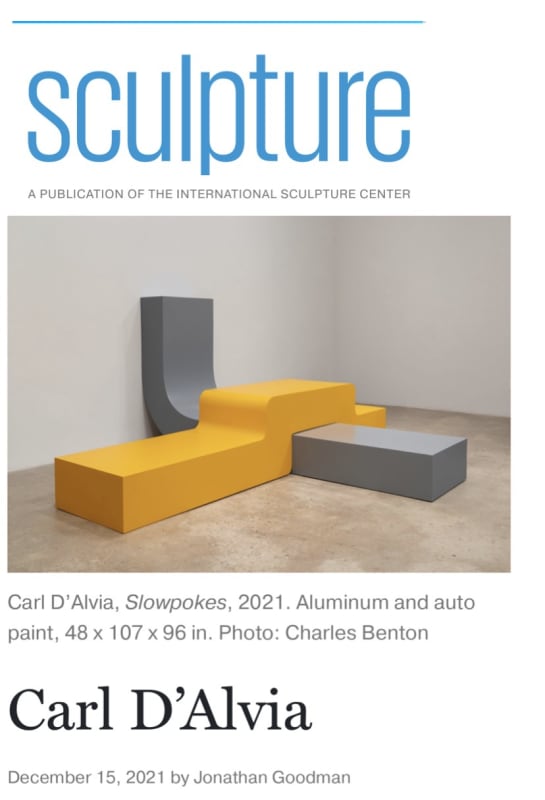Carl D’Alvia, who lived for quite some time in New York City, moved a few years ago to northwestern Connecticut, where he lives and maintains a studio. During a recent visit, we discussed the end of Modernism in art, pronouncing it a historical entity, best suited to scholars. But maybe not. D’Alvia’s abstract sculptures, while giving the impression of being completely contemporary, fuse popular culture and a formalism that originated generations ago, when high culture often entered public awareness through a rebellious appreciation of form. His recent show, “Sometimes Sculpture Deserves a Break,” featured sinuous abstractions—drunken Minimalist sculptures—mostly made of aluminum and then painted with matte coats of automobile paint.
The simple shapes demonstrate curves and rounded edges, bringing to mind the absolute simplicities of John McCracken and the complex organic forms of Elizabeth Murray. D’Alvia’s works tend to be large, with subtle changes or variations undermining the seeming regularity of the forms. Slowpokes (all works are 2021), one of the strongest pieces in the show, consists of two aluminum pieces: a curved, L-shaped form in dark gray with its back to the wall and its length advancing across the floor and a yellow element that approaches, crosses the first form, and then continues down again onto the ground. Nearly a three-dimensional jigsaw puzzle in its composition, Slowpokes is a humorous name for a serious sculpture that is architectural in its interaction with surrounding space. There is something very satisfying about the paired elements in the work, which exist in necessary conjunction, supporting and contrasting each other to create tension and unity.
Loll, in blue-painted aluminum, consists of a thick, floor-bound plane, bent and curved so that it resembles the outline of a figure stretching into child’s pose. The vertical Loaf, another curved, flat plane, seems to slouch into the wall. Colored a light salmon pink, Loaf, like many of D’Alvia’s works, makes use of an eccentric title to offset formal ambition. The simplicity may well recall Minimalism, but the touch is lighter, given more to a humorous reading of form (industrial and bodily). Humor is hard in sculpture, but D’Alvia has found a way of establishing a space between historical convention and the belief that art can be made for enjoyment alone.
Nugget, a standing red oblong with a triangular cut splitting it in two from the middle to the ground, looks like a fragment of an alphabet letter—an “a” that is not quite complete. Frizz is particularly funny with its accordioned, softly curved purple shapes seemingly inching into the wall, where they rise into a connected slab, purple on the lower part and a dirty yellow as the form rises upward. It is as if the purple slab had developed a head of foam. Here, as with each piece, enjoyment takes command.
D’Alvia’s understanding of Pop art and Minimalism enables him to spoof recent art history and his immediate predecessors, even as he creates a body of work more formally serious than it would seem at first glance. The accessibility does not preclude sophistication and intelligence, and these works, which blend the uneasiness of the minimal impulse with close attention to what is appealing, might well succeed on an even larger scale as public pieces.


